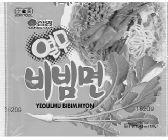BET YOU DIDN’T KNOW that over 40 billion servings of ramen (those bricks of instant Asian noodles in cellophane packaging) are consumed worldwide each year. At the 1999 World Ramen Summit in Indonesia, delegates aimed to increase that figure to 100 billion by the year 2010. Will we all be part of these rising numbers? Very likely. Ramen, which originated in Japan, is so popular that it’s sold in vending machines. There’s even the Shin-Yokohama Ramen Museum (www.bento.com/phgal3.html), which is part restaurant and part 1950s theme park, outside Tokyo.
I spent a good portion of my childhood in South Korea, and one of my earliest memories involves a baby-sitter cooking a pot of ramen. During the third (and final) minute of cooking, she cracked an egg into the soup, thereby creating a perfectly poached treat that floated in the salty broth. We bonded by sharing that egg. Years later, when I visited Korea as an Americanized teenager, I watched a documentary film about the importance of ramen to the Korean food industry. It was ramen propaganda, touting ramen as a way of life. On the screen were office workers on their lunch breaks slurping up steaming bowls of noodles while a voice-over stated that ramen was a staple of the Korean diet—a fact that was rather alarming, considering that ramen is about as nutritious as potato chips.
Ramen’s fat content ranges from 14 to 22 grams per package. (I stopped eating ramen around the same time I started using a Stairmaster.) Regardless of its scant nutritional value, ramen is popular because of its low cost and speedy preparation time. Students are prime candidates: In college it was easy to recognize an all-night study session in progress, because someone would be nuking some ramen in the dorm’s communal kitchen.
Some people like to crumble it up and eat it raw, like a poor man’s Chex Mix. The more adventurous, however, might want to log onto the Official Ramen Homepage (www.mattfischer.com/ramen), hosted by a University of Missouri student. It contains 172 different recipes submitted by ramen connoisseurs all over the US. Some of the more exotic entries include “Polish Chili Ramen,” “Orange Ramen Pancakes,” “Drunken Velveeta Ramen,” “Spicy Hooter Ramenghetti,” “Ramen Flamb鬢 and “Ghetto Ramen”—the latter being an open-faced sandwich of cooked ramen on white bread.
But you don’t have to add rum or processed cheese to make your ramen special. Go to Uwajimaya in the International District and you’ll find about 100 varieties from Japan, Korea, China, Taiwan, and Thailand. Not all ramen is alike. Some of the fancier kinds contain packages of oyster sauce, soy sauce, or red pepper oil instead of the usual powder. Some ramen contains dried tofu and seaweed. You get what you pay for: Better ramen goes for anywhere from 60 cents to $2.49. It’s all about packaging and presentation. There’s Kung Fu Ramen for the athlete; there’s a Korean brand called Dosirac, whose label features a picture of a smiling nurse; and, of course, there’s Pok魯n ramen, which rings in at a not-cheap $1.99.
Like other alimentary favorites of one’s youth, such as cookie dough or banana splits, grownups are returning to the familiar packages of instant noodles. I know several sensible adults, myself included, who have recently rediscovered the joys of ramen. Perhaps it’s a form of rebellion against dieting. Perhaps it’s that I recently watched a group of college students at Safeway load their cart with ramen during a 10-packages-for-a-dollar sale. Whatever the reason, the nostalgia factor is high. Hold a hot bowl of ramen on a cold, rainy day, and it becomes something more than just a cheap lunch; it provides a little bit of escape. Soon, you might find yourself craving the soft noodles and hot, savory broth during the most unexpected hours. A friend of mine, who happens to be a doctor, tried to suppress the urge and found herself eating ramen for breakfast. She saved several lives that day.
More cheap meals! Read about thrifty eatin’ on Capitol Hill.








